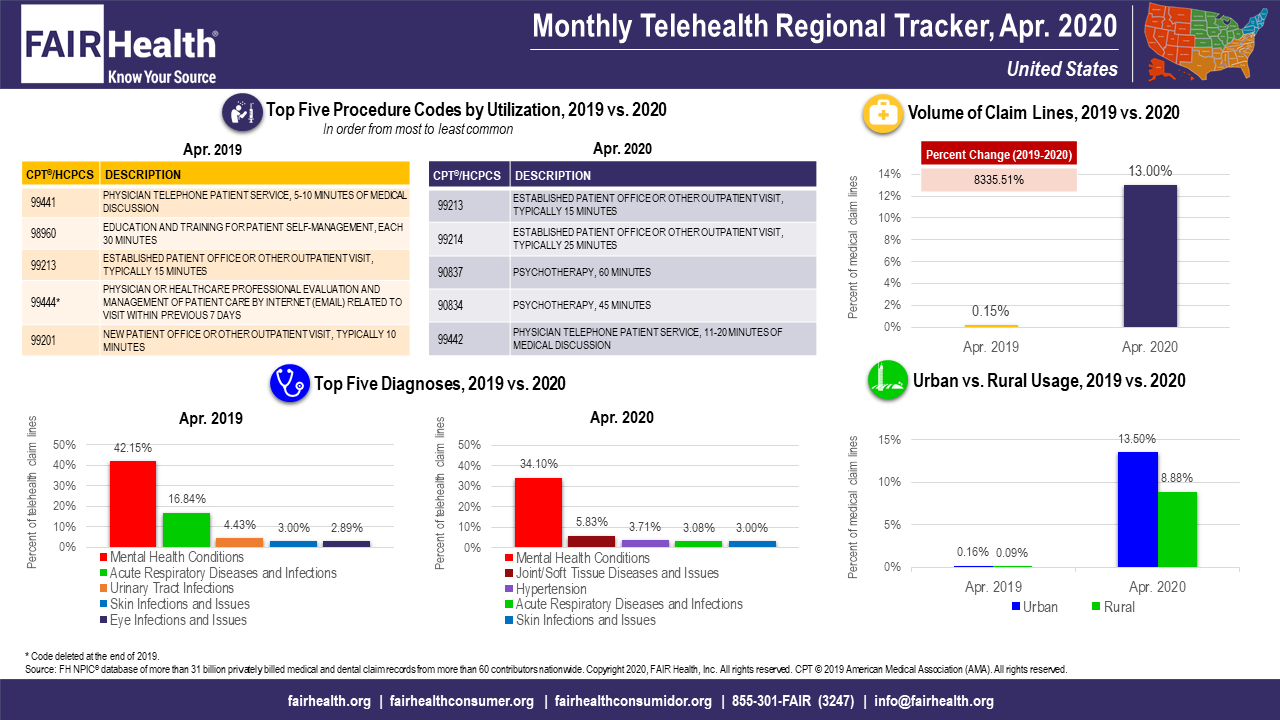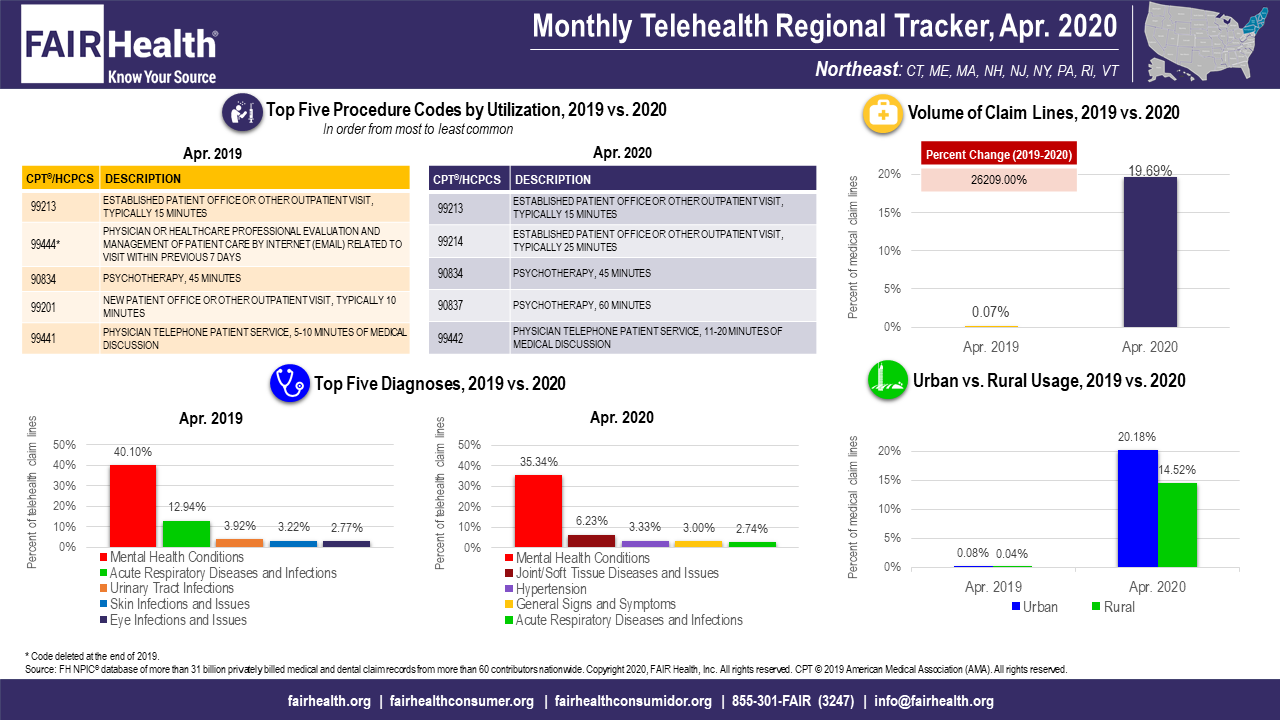Article
Telehealth Growth in April Suggests Continuing Impact of COVID-19
Author(s):
The explosive growth of telehealth seen in March 2020 continued unabated in April, claims data show.
Telehealth claim lines1 ncreased 8,336% nationally, from 0.15% of medical claim lines in April 2019 to 13.00% in April 2020, according to new data from FAIR Health’s Monthly Telehealth Regional Tracker (Figure 1). The data represent the privately insured population, excluding Medicare and Medicaid.
FIGURE 1. Monthly Telehealth Regional Tracker, April 2020, United States

Source: FAIR Health
In a sign that the increase is related to the COVID-19 pandemic, the change continued and intensified a trend that began the month before, in March 2020, when the pandemic started its rapid escalation in the United States. The April 2019 to April 2020 increase of 8,336% almost doubled the 4,347% growth that occurred from March 2019 to March 2020.
In the Northeast, the region of the country where the pandemic hit hardest in March and April, telehealth growth was even more pronounced. Telehealth claim lines in the Northeast increased 26,209% from 0.07% of medical claim lines in April 2019 to 19.69% in April 2020 (Figure 2). This increase was even larger than the already sizable 15,503% growth in the Northeast from March 2019 to March 2020.
FIGURE 2. Monthly Telehealth Regional Tracker, April 2020, Northeast

The swift growth of telehealth in March and April of this year fulfills expert predictions related to COVID-19. Telehealth permits healthcare services to be delivered without in-person contact, reducing the risk of disease transmission, and frees up in-person healthcare resources for COVID-19 patients. For those reasons, federal and state regulations related to telehealth have been relaxed, and private payers have expanded access to telehealth. In addition, with fewer elective procedures occurring around the country due to widespread restrictions, the telehealth share of total medical claim lines was expected to increase.
Telehealth grew markedly from April 2019 to April 2020 in other US census regions, but not as much as in the Northeast. In the West, the increase as a percentage of medical claim lines was 3,967%; in the Midwest, 6,754%; and in the South, 6,039%. In each region, the increase from April 2019 to April 2020 was greater than from March 2019 to March 2020.
Nationally and in all regions except the Midwest, telehealth had a greater share of medical claim lines in urban than rural areas in April 2019 and April 2020. In the Midwest, telehealth had a greater share in rural areas in April 2019, but the greater percentage shifted to urban areas in April 2020.
Other notable findings of the Monthly Telehealth Regional Tracker concern the top 5 telehealth diagnoses:
- In the Midwest, diabetes mellitus appeared as one of the top 5 diagnoses in April 2020, a position it had not occupied in April 2019. This suggests that because in-person care was less accessible during the pandemic, telehealth was being used increasingly to treat chronic conditions like diabetes as well as acute ones.
- Joint/soft tissue disorders and issues were not in the top 5 diagnoses in April 2019 nationally or in any region except the West, but in April 2020 they were in the top 5 nationally and in every region. This suggests that telehealth was being used during the pandemic for conditions for which it was previously less commonly used.
- Hypertension climbed from number 4 in the top 5 diagnoses nationally in March 2020 to number 3 in April 2020. This may be related to increased stress during the pandemic and to increased telemonitoring of patients with hypertension.
Launched in May as a free service, the Monthly Telehealth Regional Tracker uses FAIR Health data to track how telehealth is evolving on a monthly basis. An interactive map of the 4 US census regions allows the user to view an infographic on telehealth in a specific month in each region, or in the nation as a whole. In addition to data on the volume of claim lines, urban versus rural usage, and diagnoses, each infographic includes findings on the top five telehealth procedure codes.
FAIR Health is a national, independent nonprofit organization dedicated to bringing transparency to healthcare costs and health insurance information. Month by month, FAIR Health’s Monthly Telehealth Regional Tracker is showing the impact of COVID-19 on telehealth. Our data indicate that this venue of care is being transformed at a rapid pace.
Notes
1. A claim line is an individual service or procedure listed on an insurance claim.
Author Information
Robin Gelburd, JD, is the President of FAIR Health, a national, independent nonprofit organization with the mission of bringing transparency to healthcare costs and health insurance information. FAIR Health possesses the nation’s largest collection of private healthcare claims data, which includes over 31 billion claim records contributed by payors and administrators who insure or process claims for private insurance plans covering more than 150 million individuals. Certified by the Centers for Medicare & Medicaid Services (CMS) as a national Qualified Entity, FAIR Health also receives data representing the experience of all individuals enrolled in traditional Medicare Parts A, B and D; FAIR Health includes among the private claims data in its database, data on Medicare Advantage enrollees. Ms. Gelburd is a nationally recognized expert on healthcare policy, data and transparency.
Source: FAIR Health





